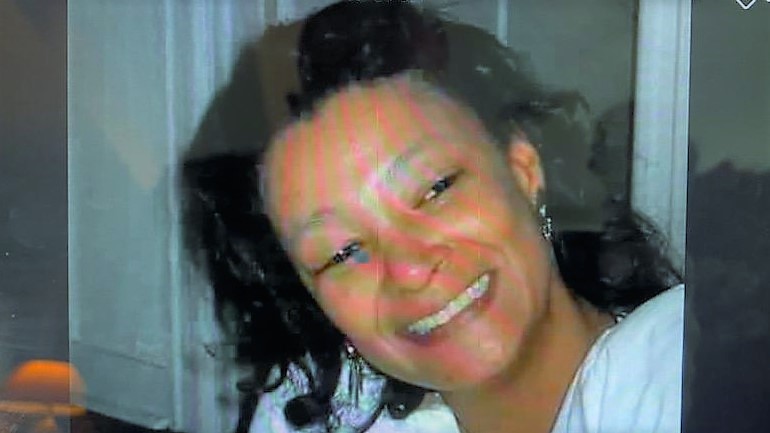NEW: DC 911 mistake & delay confirmed in case where woman died
Industry publication "Communications Daily" FOIA request confirms an almost 20-minute response time while 13-year-old daughter did CPR
Warning: Above is the 911 call from a 13-year-old girl reporting her mother, Sheila Shepperd, had collapsed. The girl did CPR on her mother. DC 911 sent DC Fire & EMS to the wrong address. It is difficult to listen to.
Looking for a quality used fire truck? Selling one? Visit our sponsor Command Fire Apparatus
Read Communications Daily story
A 13-year-old girl did everything right in her valiant efforts to save her dying mother, but no DC government leader showed the humanity or had the guts to publicly say DC 911 failed her. Not Mayor Muriel Bowser. Not then Deputy Mayor Kevin Donahue. Not current Deputy Mayor Roger Mitchell. Not Office of Unified Communications (OUC) director Karima Holmes. And not Council member Charles Allen, the person responsible for OUC oversight.
Instead, since STATter911’s initial reporting about the June incident and scores of other wrongly dispatched calls, City leaders frequently highlight the fact that while 911 centers make mistakes, the public often provides bad addresses. In addition, both Bowser and Holmes — rather than acknowledge serious 911 center problems — consistently downplay STATter911 reporting. Bowser told reporters at a press briefing, “I’m not going to go down that rabbit hole with Dave Statter.” Holmes said to a radio talk show host “Dave Statter is not my oversight” and most of his reporting was found to be “baseless”. But nowhere in their public responses did any DC official admit a 911 call-taker made a tragic mistake. No one confirmed OUC sent DC Fire & EMS to the wrong quadrant of the city, resulting in a 20-minute response time while a teenaged girl waited, performing CPR on her mother and watching her die.
But those facts are now confirmed by OUC’s own 911 recordings and documents. This new information comes from Communications Daily, a national publication known as “the bible of the telecom industry.” The excerpts below, are reprinted with permission.
The wrong units were dispatched to the wrong address
On June 5 — a Friday afternoon — the 13-year-old girl called DC 911. She desperately tried to get help for her mother, Sheila Shepperd. Shepperd, a DC lawyer, was a 59-year-old woman who had chest pains, passed out and went into cardiac arrest in front of her daughter. What the girl didn’t know as she talked to the 911 call-taker and followed CPR instructions is this: Despite what OUC told her, help was not immediately on the way.
STATter911 discovered and reported four days after the 911 call that DC Fire & EMS was dispatched to the wrong quadrant of the city. As confirmed then by a recording of the radio traffic (above), Paramedic Engine 11 and other units were sent to 414 Oglethorpe Street in Northwest. The address where Sheila Shepperd was dying was eight blocks away, at 414 Oglethorpe Street in Northeast.

The officer of Engine 11 didn’t discover they were at the wrong location until his crew quickly donned personal protective equipment and knocked on the door of the home in Northwest. Upon learning of the mistake, the officer realized something OUC workers should have recognized, but didn’t: Engine 11 was now closer to the correct address in Northeast than the fire company that should have been initially dispatched.
Engine 11’s officer told OUC they would also respond to the correct address. When they finally arrived at the correct location, crews confirmed Sheila Shepperd was in cardiac arrest. Shepperd was taken to nearby Washington Hospital Center where, like the fire and EMS crews, the emergency department staff was unable to revive her.
Despite STATter911’s repeated questions about the Oglethorpe Street incident, OUC never responded or explained how this error occurred. Just hours after the STATter911 story was published, DC Council member Charles Allen asked OUC director Karima Holmes about our reporting (above). Holmes provided no specifics about what went wrong. Now, the Communications Daily team of Adam Bender and Jonathan Make have the answer: A DC 911 call-taker failed to enter the address correctly in the dispatch computer.
Communications Daily has been sending OUC Freedom of Information Act (FOIA) requests about some of the many failures reported by STATter911. They’ve confirmed OUC mistakes in four incidents, so far. Here’s an excerpt from Communications Daily’s new reporting about Sheila Shepperd’s death. It’s based on OUC’s own audio recordings (audio at the top of this post) and written logs:
“What’s the location of your emergency?” asked a District of Columbia Office of Unified Communications 911 call taker on June 5 just before 4 p.m. The caller, crying as she reported that her 59-year-old mother passed out after experiencing chest pains, answered, “414 Oglethorpe Street Northeast.”
“I’m sorry, can you repeat that?” asked the call taker. The daughter replied, “414 Oglethorpe Street Northeast, Washington, D.C.” At 3:58 p.m., the address was entered into OUC’s event log as 414 Oglethorpe St. NW. That’s about 1.5 miles away in a different quadrant of the city, according to Google Maps.
About five and a half minutes into the 911 call, the daughter said her mother was gasping for air and asked if the call taker knew how long it would take responders to arrive. “I can’t give an absolute ETA, but they’re en route,” the operator replied. “You should be seeing them shortly.” Less than a minute later, the caller said her mom stopped breathing. The call taker instructed her to start CPR and began counting one to four to assist with the timing of the chest compressions. That continued for much of the rest of their approximately 20-minute conversation before paramedics arrived.
Transparency & accountability
Instead of coming clean about what went wrong, OUC and DC leadership was comfortable letting the public think it possible that Sheila Shepperd’s daughter may have provided the wrong quadrant. City officials could have immediately cleared this up, but chose not to. In every public statement, they responded in generalities about this case and the other incidents STATter911 documented, never providing specifics about OUC failures.
Here’s what Holmes and Allen told WTOP Radio’s Neal Augenstein on September 3:
“There are times when we do make a mistake. There are times when the caller provides us a wrong address, and there are times when we give an address correctly and the responders interpret that address incorrectly,” said Holmes.
“We depend on fast-thinking staff to stay on the line, and then correct and relay that information to folks on the ground. That is the reality of 911: you’re calling at your worst moment, and you might not be fully aware of where you are or what’s going on around you.”
And here’s what Holmes told WAMU’s Kojo Nnamdi on the same day:
We have investigated many of these calls that Statter has alleged that we dispatch incorrectly, and most of them are found to be baseless. And just to refute quickly a couple of them that I recently — which were recently brought to my attention, there was a call he says we had done incorrectly on Randolph Street. The caller gave us that wrong address. We verified it three times.
Another CPR call sent to the wrong address
It’s true, callers often make mistakes when talking to 911. It’s also true 911 call-takers and dispatchers, well-trained in local geography and streets, with good active listening and critical thinking skills can often help correct those mistakes and promptly get the right help to the right location. Communications Daily confirmed that a caller did provide the wrong address on another incident reported by STATter911.
The same day we told you about Oglethorpe Street, we provided the radio traffic (above) for a May 17 call for a reported childbirth. DC Fire & EMS was first sent to the wrong address and it was almost 45-minutes before fire & EMS was at the correct apartment building reporting the newborn was in cardiac arrest. While Communications Daily now confirms mistakes were made at both ends of the emergency call, it’s still not clear why it took so long to correct the problem and get help where it was needed:
Both the caller and OUC appeared to make mistakes in a May 17 incident involving an unexpected childbirth at an apartment in northwest Washington. The call taker repeatedly asked questions about the baby’s status while trying to direct the distracted adults.
At about 3:30 a.m., a man reported his 26-year-old “lady friend” just gave birth. It sounded like he gave 3100 Massachusetts Ave. NW as the address, but the written log showed 3100 Wisconsin Ave. NW. “I’ve got them both in the tub,” the man said. “Come immediately, ma’am, please.”
“Hold on, I’ve got somebody coming,” the call taker replied.
About seven minutes into the call, the operator said the paramedics had arrived and were coming up. About five minutes later, the operator asked, “They at the door?” No, he replied.
The call taker asked for the apartment number again, then the street address. This time, the caller said 4100 Massachusetts Ave. NW, 10 blocks from the location he originally gave and a different street from what was in the written log. The address was corrected in the log shortly afterward.
“We are going to 3100 Wisconsin, correct?” a responder asked. That’s about 1.1 miles from 4100 Massachusetts Ave. NW.
Wrong quadrants are a consistent problem
Communications Daily was also able to confirm it was OUC that couldn’t get the quadrant right for a person having a seizure near the Gallery Place Metro. As we first reported shortly after the July 21 incident (above), OUC sent Ambulance 3 to 7th and H in Northeast. Here’s what Communications Daily discovered:
On July 21 at about 5:50 p.m., a woman called 911 to report a man having a seizure near the AT&T store at the Gallery Place Metrorail station in northwest Washington. The log showed the phone reporting the call coming from 650 Massachusetts Ave. NW, less than two blocks from that store. The call taker asked if the cross streets were Seventh and H. The caller said yes. The written log shows Seventh Street Northeast and H Street Northeast entered, which is the wrong quadrant for Gallery Place and 1.7 miles away.
A written entry at 5:57 p.m. reported the caller no longer on scene. A first responder asked the dispatcher if the location was Northeast, “because the caller address came up as Northwest.” The dispatcher later reported that a callback to the person who dialed 911 went to voicemail. The responder said they would check the Northwest quadrant, and a 5:58 written entry notes that Ambulance 3 “IS GOING TO THE NW SIDE.”
The address remained Northeast in the log until 6:32 p.m., when it was corrected to Northwest. About five minutes earlier, the log showed requests for medic and EMS units. One radio recording captured a rescuer asking if the address was Northwest or Northeast. A new dispatcher responded it was Northeast. Then OUC asked Ambulance 3 in which quadrant it was located, and the ambulance replied Northwest. The medic unit then reported itself as heading to Northwest.
The written log noted a transport at about 6:54 p.m. to 2041 Georgia Ave. NW, the address of Howard University Hospital. The patient was transported in priority-three stable condition, the Fire and EMS spokesperson said.
Where is local news?
This is great work by Communications Daily. But why is a national publication doing the digging and not local news organizations?
To their credit, some news organizations like The DC Line, WAMU/DCist, WTOP, WUSA, WTTG/FOX5 and The Washington Post have followed up on some of the incidents I’ve uncovered. I’m thankful for that. But there’s no indication of anyone local doing the desperately needed deep-dive into OUC.
It’s not because local news doesn’t think 911 is important. The Post did a phenomenal reporting job in August on botched 911 calls mishandled in both Loudoun County, Virginia and Montgomery County, Maryland after a young man drowned. The story was then picked up by multiple local radio and TV stations. Reporters Dan Morse and Justin Wm. Moyer hit all the right points and focused on problems afflicting many 911 centers. They also uncovered a mutual aid policy about Potomac River incidents that negatively impacted the handling of the call.
Somehow the Post and others keep ignoring a more serious and frequent pattern of mistakes at DC 911. For the past year, I’ve shared not just scores of bad addresses, but a host of dispatching problems that point to systemic problems inside OUC. These include:
- Delayed dispatching to Metrorail and other emergencies
- Fire & EMS life-saving resources wasted by both the constant duplication of responses and the failure to properly classify EMS calls
- Abandoned emergency radio channels that have left DC Fire & EMS calls for help unanswered
- A consistent failure to properly relay important information to DC Fire & EMS, to include not sharing key safety information, address changes and calls that have been cancelled
The ground work has been done and is available to any reporter willing to take a serious look into why these things keep happening at OUC. All of my reporting is clearly documented by radio traffic, including a couple Potomac River incidents that illustrate some of the same problems highlighted in the Loudoun-Montgomery reporting.
Can you spot what’s different?
In addition to the much greater number of 911 mistakes in DC compared to Loudoun and Montgomery, there are other important differences. After the tragic drowning of 16-year-old Fitz Thomas there was transparency and accountability. The people in charge spoke on the record to reporters about the failures. There was a detailed report about what went wrong released to the public. Elected and appointed officials let the public know their disappointment and vowed to correct the problems. Compare that to what happened after Sheila Shepperd died just hours after Fitz Thomas.
No transparency. No accountability. No outrage by elected officials. A campaign to shut down the messenger rather than fix the problem. And by far, the greatest insult — refusing to make clear to all that a young DC resident heroically did her job, while DC 911 failed again at handling the basics of its mission.
I have a badly deviated septum, but all of that smells like news to me. It’s the type of stonewalling most good reporters love to breach. With COVID, nationwide mass protests and the election, I get there’s no shortage of important news. But I have to believe the image of that young girl pounding on her mother’s chest believing help will soon arrive is finally enough to inspire someone with a DC Police press pass to take a serious look into why this keeps happening at DC 911.
The excerpts from the Communications Daily article are reprinted with permission of Warren Communications News. Do not further redistribute without written permission from Warren: www.communicationsdaily.com, 202-872-9200 or sales@warren-news.com.






